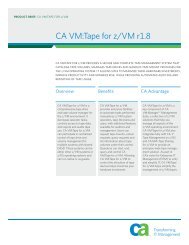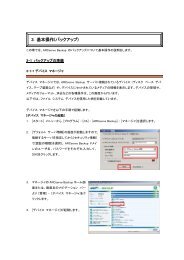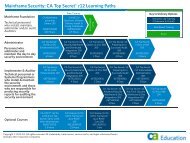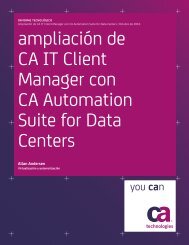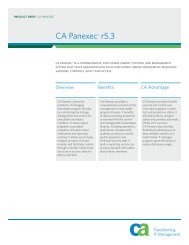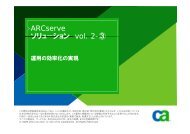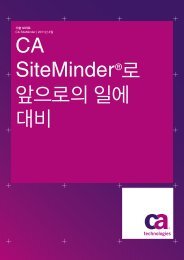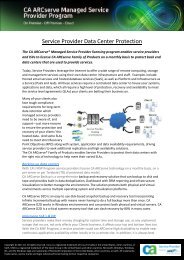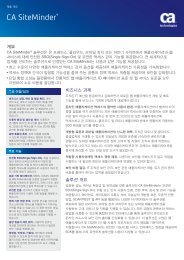Content-Aware Identity and Access Management - CA Technologies
Content-Aware Identity and Access Management - CA Technologies
Content-Aware Identity and Access Management - CA Technologies
Create successful ePaper yourself
Turn your PDF publications into a flip-book with our unique Google optimized e-Paper software.
TECHNOLOGY BRIEFJanuary 2012<strong>CA</strong> <strong>Technologies</strong>point of view:<strong>Content</strong>-<strong>Aware</strong><strong>Identity</strong> <strong>and</strong> <strong>Access</strong><strong>Management</strong>Sumner BlountSecurity <strong>Management</strong>, <strong>CA</strong> <strong>Technologies</strong>agilitymade possible
<strong>CA</strong> Point of View: <strong>Content</strong>-<strong>Aware</strong> <strong>Identity</strong> <strong>and</strong> <strong>Access</strong> <strong>Management</strong>The following graphic highlights these key areas <strong>and</strong> indicates the capabilities that are essentialfor each one.Figure A.What is <strong>Content</strong>-<strong>Aware</strong> IAM?The essence of <strong>Content</strong>-<strong>Aware</strong> IAM is the ability to manage all of the areas defined above: identities,access, <strong>and</strong> information usage. Controlling identities lets you efficiently manage your users, their roles,<strong>and</strong> their access rights across the enterprise. Controlling access allows only properly authorized individualsto gain access to your critical systems <strong>and</strong> applications. But, this is not enough for a unified approach tosecurity <strong>and</strong> compliance. Controlling information usage is critical because it helps to prevent theinappropriate theft or disclosure of confidential enterprise or customer information. This capabilityenables you to create policies that define certain classifications of data <strong>and</strong> the operationsor actions that will not be permitted on that data.<strong>Content</strong>-<strong>Aware</strong> IAM is not a st<strong>and</strong>-alone technology, but an integrated set of IAM components that createa unified solution. This implies that entitlement management, role management, provisioning, <strong>and</strong> evenaccess management are all “content-aware” in the sense that their functionality is integrated with, <strong>and</strong>impacted by, the classification <strong>and</strong> usage of the information. We’ll see in a later section how this works,<strong>and</strong> the benefits it provides.Many traditional vendors tout that their solutions are “context aware,” which some people confuse withthe concept of content-aware. “Context aware” implies that certain contextual attributes are used toenhance the granularity of the enforcement of access policies. For example, contextual attributes could6
<strong>CA</strong> <strong>Technologies</strong> Point of View: <strong>Content</strong>-<strong>Aware</strong> <strong>Identity</strong> <strong>and</strong> <strong>Access</strong> <strong>Management</strong>Section 3:The <strong>CA</strong> <strong>Technologies</strong> architecture for<strong>Content</strong>-<strong>Aware</strong> IAMThe <strong>Content</strong>-<strong>Aware</strong> IAM suite from <strong>CA</strong> <strong>Technologies</strong> includes a broad set of integrated solutionsthat help control the key aspects of your IAM environment. Full descriptions of each product areat www.security.com. The key categories, the component products, <strong>and</strong> their capabilities include:• Control identities identities (<strong>CA</strong> GovernanceMinder, <strong>CA</strong> <strong>Identity</strong>Minder, <strong>CA</strong> User ActivityReporting) Control identities by managing <strong>and</strong> governing what they can access based on their role. Italso includes user activity <strong>and</strong> compliance reporting.IAM from <strong>CA</strong> <strong>Technologies</strong> provides complete identity lifecycle management that addresses the evolvingrequirements associated with ensuring users have appropriate <strong>and</strong> timely access to the applications,systems, <strong>and</strong> data they need while establishing appropriate processes <strong>and</strong> controls to minimize securityrisk. <strong>Identity</strong> Governance supports controls to prevent business <strong>and</strong> regulatorypolicy violations (such as segregation of duties) <strong>and</strong> automates the process of validating user accessto reduce security risk. Provisioning enables the automation of processes for on-boarding, modifying, <strong>and</strong>off-boarding users <strong>and</strong> their associated access. Self-service enables end users to initiate provisioningactions, password management, <strong>and</strong> related processes. Role <strong>Management</strong> efficiently representsusers<strong>and</strong> their required access (including roles, policies, access rights, etc.) as a foundation of unified identityprocesses. Finally, User Activity <strong>and</strong> Compliance Reporting provides improved security <strong>and</strong> easiercompliance through reporting on compliance <strong>and</strong> user activity events.• Control access (<strong>CA</strong> SiteMinder®, <strong>CA</strong> ControlMinder, <strong>CA</strong> AuthMinder, <strong>CA</strong>RiskMinder) Controlaccess to systems <strong>and</strong> applications across physical, virtual, <strong>and</strong> cloud environments.IAM from <strong>CA</strong> <strong>Technologies</strong> provides extensive capabilities to control access to protected systems<strong>and</strong> applications, across a range of platforms <strong>and</strong> environments. Web <strong>Access</strong> <strong>Management</strong> providesa centralized approach to the enforcement of policies that determine who can access your critical onlineapplications, <strong>and</strong> the conditions under which that access is allowed. Centralizing application accessenforcement outside of the applications themselves helps to simplify <strong>and</strong> reduce the cost of securitymanagement, <strong>and</strong> to promote consistent security enforcement. It also provides web single sign-on forincreased productivity <strong>and</strong> reduced Help Desk costs. Federation provides for secure access to externalpartner applications <strong>and</strong> data to enable partner ecosystems that support your business growth.Privileged User <strong>Management</strong> provides granular control over what your administrators can do on your keysystems. It significantly enhances the security provided by native operating systems. It secures bothphysical <strong>and</strong> virtual systems, <strong>and</strong> securely tracks, logs, <strong>and</strong> reports all privileged user activities.Virtualization Security helps protect your systems <strong>and</strong> applications that are deployed in a virtualenvironment from attack or misuse, either externally or from cross-VM activities. AdvancedAuthentication <strong>and</strong> Fraud Prevention provide flexible capabilities for improving the strength of your userauthentication, including risk-based authentication to help identify <strong>and</strong> prevent attempted fraudulentactivities. It also enables you to avoid the high cost <strong>and</strong> reduced user convenience of hardware tokens,while improving your overall security.8
<strong>CA</strong> <strong>Technologies</strong> Point of View: <strong>Content</strong>-<strong>Aware</strong> <strong>Identity</strong> <strong>and</strong> <strong>Access</strong> <strong>Management</strong>• Control information (<strong>CA</strong> DataMinder) Find, classify, <strong>and</strong> control how information is used basedon content <strong>and</strong> identity.<strong>CA</strong> DataMinder identifies sensitive data across the enterprise in real time <strong>and</strong> determines whetheror not end users are using that data in accordance with various security <strong>and</strong> regulatory m<strong>and</strong>ates. Itidentifies <strong>and</strong> classifies all sensitive data; examples include personally identifiable information (PII),intellectual property (IP), <strong>and</strong> nonpublic information (NPI). It controls sensitive data at all locations:at the endpoint, on the server, on the network, or stored across the enterprise.Many companies have faced the negative effects of sensitive information being emailed outsidecorporate boundaries. Sometimes this comes from malicious insiders, but often it’s simply a careless butdangerous act. <strong>CA</strong> DataMinder can analyze all email to identify <strong>and</strong> prevent sensitive information frombeing sent to the wrong person. The result is reduced risk of improper information disclosure.The following graphic highlights information flow between the IAM components. It also highlights howthe Classification Service provides information about information content to each component, resulting inincreased granularity of access <strong>and</strong> usage enforcement, as well as content-aware role management.Figure B.The <strong>Content</strong>-<strong>Aware</strong> IAM architecture from <strong>CA</strong> <strong>Technologies</strong>.ID GovernanceRole Mgt<strong>Identity</strong>AnalyticsID MgtProvisioningEntitlementsProvisionRisk AnalysisReportingWeb <strong>Access</strong> Mgtw/SSOAdvancedAuthenticationPrivileged User<strong>Management</strong>InformationProtection &Control<strong>Access</strong>EnforcementAudit CollectionUser Activity & Compliance ReportingReportingAn important strength of <strong>Content</strong>-<strong>Aware</strong> IAM from <strong>CA</strong> <strong>Technologies</strong> is the level of integration among thecomponents. This level of integration helps to simplify administration <strong>and</strong> foster consistencyof interfaces across all components. And, simpler administration means lower costs.9
<strong>CA</strong> <strong>Technologies</strong> Point of View: <strong>Content</strong>-<strong>Aware</strong> <strong>Identity</strong> <strong>and</strong> <strong>Access</strong> <strong>Management</strong>In addition, these products can improve security for new or emerging service models, such as virtualized orcloud environments. As you take advantage of virtual computing, you will want to ensure that the physicalmachines that host your virtual environments are fully protected from attack or cross-VM access. In asimilar way, as you move to cloud computing, you need to make this transition as easy <strong>and</strong> secure aspossible. <strong>Content</strong>-<strong>Aware</strong> IAM from <strong>CA</strong> <strong>Technologies</strong> facilitates your ability to make this transition securelyso that you business can take advantage of these new <strong>and</strong> important service <strong>and</strong> technology models.<strong>Content</strong>-<strong>Aware</strong> IAM from <strong>CA</strong> <strong>Technologies</strong> provides important capabilities to leverage information contentknowledge to improve overall security, including:• <strong>Content</strong>-<strong>Aware</strong> information classification Data needs to be classified according to the model of datasensitivity of each organization. For example, there should be major categories of information sensitivity(examples: corporate confidential, customer private, intellectual property, nonpublic info, etc.), aswell as levels of sensitivity within each category. This process today is usually manual, highly timeconsuming<strong>and</strong> error-prone, <strong>and</strong> often completely omitted. <strong>CA</strong> DataMinder can analyze <strong>and</strong> classifysensitive information (using either static or dynamic analysis) <strong>and</strong> then control its usage to preventmisuse. Traditional IAM vendors do not provide this important capability, <strong>and</strong> this is the foundationon which <strong>Content</strong>-<strong>Aware</strong> IAM is based.• <strong>Content</strong>-<strong>Aware</strong> provisioning The integration of <strong>CA</strong> <strong>Identity</strong>Minder <strong>and</strong> <strong>CA</strong> DataMinder provides trueidentity-centric information protection. <strong>CA</strong> <strong>Identity</strong>Minder can directly provision, de-provision, <strong>and</strong>modify users into the <strong>CA</strong> DataMinder user hierarchy. As users’ roles change, <strong>CA</strong> <strong>Identity</strong>Minder passesthose changes into <strong>CA</strong> DataMinder, which ultimately changes each user’s data usage entitlements.• <strong>Content</strong>-<strong>Aware</strong> web access management <strong>CA</strong> SiteMinder can use information classification in its policyenforcement decisions, thereby providing you with increased granularity in how you define your access<strong>and</strong> usage policies. This enables <strong>CA</strong> SiteMinder to make the access decision based not only on whetherthe user is authenticated <strong>and</strong> authorized for access, but also on the sensitivity of the resource asdetermined by the DLP Classification Engine. So, for example, access to a document posted in aSharepoint portal by mistake can be prevented dynamically by <strong>CA</strong> SiteMinder based on the sensitivityof the data.• <strong>Content</strong>-<strong>Aware</strong> role management Information usage policies should be both identity- <strong>and</strong> role-based,because individuals who share a given role are very likely to have the same usage entitlements. The usagepolicies of <strong>CA</strong> DataMinder will be integrated with the role management model <strong>and</strong> associated securitypolicies of <strong>CA</strong> GovernanceMinder, so that information usage policies can be tied directly to the businessroles that are associated with these policies. This helps eliminate ad hoc approaches to business roles<strong>and</strong> results in more efficient management of users <strong>and</strong> their usage policies.• <strong>Content</strong>-<strong>Aware</strong> identity certification Many regulations <strong>and</strong> best practice st<strong>and</strong>ards require regularmanagement certification of user entitlements to confirm that each user has the appropriate accessprivileges. Many organizations don’t regularly review their user entitlements, <strong>and</strong> those that do generallydo it manually, resulting in increased risk <strong>and</strong> inefficient processes. Automated identity certification notonly increases efficiency by automating a typically manual process, but it also helps to identify <strong>and</strong>eliminate cases of over-privilege among the user population. With the integration of <strong>CA</strong> DataMinder <strong>and</strong><strong>CA</strong> GovernanceMinder, identity certification will include a validation of not only an employee’s accessrights, but also their information usage entitlements.10
<strong>CA</strong> <strong>Technologies</strong> Point of View: <strong>Content</strong>-<strong>Aware</strong> <strong>Identity</strong> <strong>and</strong> <strong>Access</strong> <strong>Management</strong>• <strong>Content</strong>-<strong>Aware</strong> compliance reporting When information access <strong>and</strong>/or policies are violated, it isessential that this becomes visible to security or compliance managers so that they can take quickremedial action, <strong>and</strong> is included in compliance reports so that the overall compliance profile of theorganization is known. To provide this capability, <strong>CA</strong> User Activity Reporting (an add-on component) willcapture the results of attempted usage policy violations that are prevented by <strong>CA</strong> DataMinder <strong>and</strong>include this information, correlated with other relevant access activity, in compliance reports. <strong>Content</strong>-<strong>Aware</strong> compliance reporting provides a more accurate view of the state of information usagecompliance, <strong>and</strong> can be used in conjunction with other identity-related compliance information tosimplify <strong>and</strong> reduce the total costs of compliance audits.Section 4: Scenarios for <strong>Content</strong>-<strong>Aware</strong> IAMLet’s consider some very common <strong>and</strong> instructive scenarios to illustrate how an integrated approachto <strong>Content</strong>-<strong>Aware</strong> IAM can enforce security policies <strong>and</strong> help automate security processes. These cases arenot exhaustive, but they are representative of some of the important security <strong>and</strong> efficiency benefits thatcan be gained.Provisioning of users based on roles <strong>and</strong> policiesBob Butler was hired as a software developer at Forward, Inc. When he was hired at his previous company, itwas two weeks before he had access to all of the systems <strong>and</strong> files that he needed to do his job. During thatprocess, all his accounts <strong>and</strong> access rights had to be manually created, but only after a paper form wassigned by each system admin <strong>and</strong> sent back to the IT admin. During this time delay, Bob becamefrustrated because he wasn’t as productive as he needed to be. In addition, during the four years Bob wasthere, he changed projects several times, <strong>and</strong> each time he never lost his access privileges for the previousprojects <strong>and</strong> roles. As a result, when he left, he had accumulated significantly more privileges <strong>and</strong>accounts than he needed.But, upon arrival at Forward, <strong>CA</strong> <strong>Identity</strong>Minder <strong>and</strong> <strong>CA</strong> GovernanceMinder were used to automate thecreation of his accounts <strong>and</strong> access rights <strong>and</strong> gain upper management approval through workflowprocesses. This process was done immediately <strong>and</strong> no paper approval forms were required. So, Bob wasproductive immediately, saving him much frustration <strong>and</strong> time. In addition, as his role <strong>and</strong> projectresponsibilities changed over the next three years, his access rights were automatically changed to reflecthis new responsibilities, so that he did not have more access than he needed for his current role. Finally,<strong>CA</strong> GovernanceMinder automated the certification of his entitlements so that inadvertent over-privilegeswere detected <strong>and</strong> corrected quickly.Protection of confidential recordsThe protection <strong>and</strong> privacy of medical records is a prime example of the importance of controlling not onlyaccess to information, but usage of that information. It is, for example, essential for HIPAA compliance.Stan is a nurse at Metro Hospital. As such, he has the rights to see the medical records of patients forwhom he is the assigned nurse. The hospital wants to allow access to these records only from approvedstations within the nurses’ area, <strong>and</strong> requires strong authentication when these records are accessed.Lastly, because of HIPAA concerns, the hospital requires that no online medical records be communicatedoutside the hospital’s IT environment. Unfortunately, for his own nefarious reasons, Stan wants to11
<strong>CA</strong> <strong>Technologies</strong> Point of View: <strong>Content</strong>-<strong>Aware</strong> <strong>Identity</strong> <strong>and</strong> <strong>Access</strong> <strong>Management</strong>steal some of his patients’ medical records from the hospital. Here’s how <strong>Content</strong>-<strong>Aware</strong> IAM from<strong>CA</strong> <strong>Technologies</strong> would help protect Metro Hospital:• Stan connects to the hospital network from his home PC <strong>and</strong> logs in. He tries to access his patients’records, but <strong>CA</strong> SiteMinder determines that he is not located at an approved PC (within the nurses’area), <strong>and</strong> denies his attempt. This failed attempt is logged, <strong>and</strong> the IT security manager is notified.• The next day, Stan logs into the PC in the nurses’ station. He attempts to access the records of a patientfor whom he’s not the attending nurse. <strong>CA</strong> SiteMinder passes information about Stan as context to theapplication, which then determines that he is not the attending nurse for this patient, <strong>and</strong> thereforedenies access to this patient record.• He then attempts to access his own patient’s record. Because this requires extra security, <strong>CA</strong> SiteMinderauthenticates him using his <strong>CA</strong> ArcotID software token, <strong>and</strong> access is allowed. He now has authorizedaccess to this data, but he wants to use it for unauthorized purposes.• He copies these medical records into an Excel file, <strong>and</strong> emails it to his own Gmail account.<strong>CA</strong> DataMinder analyzes the attached data that is being sent in his email, <strong>and</strong> determines that itcontains patient numbers. Because there is a data usage policy that prevents this type of data frombeing transmitted externally, the email operation is denied, an alarm is raised to the IT securitymanager, <strong>and</strong> a record of the event is put into the log file. If Stan attempts to copy the informationto a restricted device or email it to an unauthorized internal individual, the results would be the same.His attempt to steal this sensitive information has been defeated in every case.Inadvertent sharing of protected informationIn many cases, a violation of information usage policy is unintentional. That is, some user may transferinformation to a third party that is perfectly acceptable, but which includes some data that should notbe transferred.Pierre is a finance manager at a luxury retailer in Paris. This retailer has a partnership with a few keypartners in which they jointly market their products to their high-end customers. In order to develop thesejoint marketing campaigns, Pierre has been asked by his marketing manager to send the Paris-basedcustomer list to the partner so they can analyze the range of customers <strong>and</strong> determine how to market tothem. However, the st<strong>and</strong>ard customer database contains credit card information that not only cannotleave the company, but should not even be communicated to anybody internally except a select fewfinance employees, such as Pierre. Pierre is not aware of this, <strong>and</strong> is attempting to do an otherwiseappropriate business operation.Pierre attempts to access the Paris-based customer list <strong>and</strong> the request is allowed. He then downloadsthis customer information into an Excel file, <strong>and</strong> puts it on a network Share drive, to which he has giventhe partner access. Later, <strong>CA</strong> DataMinder performs a network scan <strong>and</strong> discovers a new file there, <strong>and</strong> ascan of the file determines that it contains protected information. When the partner accesses the Sharedrive <strong>and</strong> attempts to copy the data, <strong>CA</strong> DataMinder enforces the usage policy by preventing the action,<strong>and</strong> informs the compliance manager of a potential regulatory or policy violation. In this case, sensitiveinformation was protected from disclosure outside the company.12
<strong>CA</strong> <strong>Technologies</strong> Point of View: <strong>Content</strong>-<strong>Aware</strong> <strong>Identity</strong> <strong>and</strong> <strong>Access</strong> <strong>Management</strong>Protection of intellectual propertyJerry is a software developer working on a strategic application for 2Big2Fail, Inc. Because he is not aSenior Developer, he can only access portions of the large set of source files. These entitlements aredetermined by his organizational role (<strong>CA</strong> GovernanceMinder) <strong>and</strong> enforced by <strong>CA</strong> SiteMinder.Jerry is disgruntled <strong>and</strong> has accepted a job with a competitor. He is going to try to steal the application’ssource code, because he wants to bring it to his new company. He attempts to access the key source filesfor this application, but SiteMinder denies access based on his role entitlements. Next, he attempts to godirectly to the server where these files reside by using a Root password that he has used in the past. But,the Privileged User Password <strong>Management</strong> capabilities of <strong>CA</strong> ControlMinder prevent this access, as well aslogging his failed attempt.Undaunted, Jerry copies the source files that he is authorized to use to his hard drive <strong>and</strong> tries to copythem to a USB device. But, <strong>CA</strong> DataMinder analyzes the data in the transfer, determines that it is asource file, <strong>and</strong> prevents the operation. Next, Jerry tries to email the files to his Gmail account, which<strong>CA</strong> DataMinder also prevents. Finally, he attempts to FTP the files to his home computer. <strong>CA</strong> DataMinderprevents this action also, <strong>and</strong> in all these cases generates an alarm <strong>and</strong> logs the attempt. Not surprisingly,this attempted policy breach is identified quickly <strong>and</strong> Jerry becomes an ex-employee even sooner than heexpected. As he is walked out of the building, all his accounts (across many systems) <strong>and</strong> access privilegeshave already been automatically terminated by <strong>CA</strong> <strong>Identity</strong>Minder.Information protection due to improper accessCarl is a manager at Forward, Inc. <strong>and</strong> has access to an internal Sharepoint site for his group. Anotheremployee mistakenly posts a file on this site that contains customer financial information. One day, whilescanning the Sharepoint site, Carl notices this new file <strong>and</strong> attempts to open it. Before <strong>CA</strong> SiteMinderauthorizes Carl’s access to the file, it calls the <strong>CA</strong> DataMinder classification service to see if the file thatCarl is accessing is sensitive. <strong>CA</strong> DataMinder checks the content against its policies <strong>and</strong> determines thatthere is confidential information on the SharePoint site that Carl shouldn’t have access to, based on hisrole. SiteMinder then uses this classification to block Carl’s access to the information. The combinationof <strong>CA</strong> SiteMinder <strong>and</strong> <strong>CA</strong> DataMinder prevented another compliance violation.The result—a potentially serious breach of confidential information is prevented.Summary of use casesThese examples highlighted relatively common occurrences at many organizations. In these examples, we seesome compelling benefits of <strong>Content</strong>-<strong>Aware</strong> IAM. In the first example, common security processes wereautomated, thereby not only increasing efficiency, but most importantly improving security <strong>and</strong>simplifying compliance. In the other scenarios, we see the benefits of providing fine-grained controlof what each user can actually do with the information that they obtain, rather than have the policyenforcement end at the point of access. Because the damage caused by inappropriate disclosure or theftof sensitive information can be so great, <strong>and</strong> because even well-intended employees sometimes makemistakes related to the use of this information, a solution that can help prevent these situations isessential for a robust security approach.In summary, robust security <strong>and</strong> compliance requires more than what traditional IAM can offer. <strong>Content</strong>-<strong>Aware</strong> IAM provides these enhanced capabilities that offer compelling benefits to large IT organizations.13
<strong>CA</strong> <strong>Technologies</strong> Point of View: <strong>Content</strong>-<strong>Aware</strong> <strong>Identity</strong> <strong>and</strong> <strong>Access</strong> <strong>Management</strong>Section 5:Conclusions<strong>Identity</strong> <strong>and</strong> access management has been providing compelling benefits to many organizations forseveral years. But, these systems generally provide control only down to the point of access, <strong>and</strong> donot allow you to control what can be done with the information once it has been obtained. This is asignificant limitation of these platforms, because it does not completely prevent misuse or inappropriatedisclosure of your sensitive information.Innovative <strong>Content</strong>-<strong>Aware</strong> IAM solutions from <strong>CA</strong> <strong>Technologies</strong> extend this capability so as to providecontrol down to the data level, thereby providing you with more control over what users can do with yourcritical information. This integrated solution can also help reduce your IT risk, automate key securityprocesses for increased efficiencies, <strong>and</strong> enhance your overall compliance posture.IAM from <strong>CA</strong> <strong>Technologies</strong> provides you with the flexibility to choose the deployment model that fits yourbusiness <strong>and</strong> security requirements. Our core IAM capabilities are offered as cloud services (under thename <strong>CA</strong> CloudMinder), hosted in large <strong>and</strong> secure data centers <strong>and</strong> managed by <strong>CA</strong> <strong>Technologies</strong> experts.You can adopt cloud-based IAM services according to your own needs <strong>and</strong> timetables, starting with acompletely on-premise solution <strong>and</strong> then migrating certain components to the cloud as your needs <strong>and</strong>security considerations dictate. This approach offers you very high flexibility <strong>and</strong> enables you to increaseyour overall business <strong>and</strong> IT agility.The goal is to move your business forward, securely. <strong>Content</strong>-<strong>Aware</strong> IAM from <strong>CA</strong> <strong>Technologies</strong> providesthe foundation to help you achieve this goal.To learn more about the <strong>Content</strong>-<strong>Aware</strong> IAM architecture from <strong>CA</strong> <strong>Technologies</strong>, visit ca.com/iam.<strong>CA</strong> <strong>Technologies</strong> is an IT management software <strong>and</strong> solutions company withexpertise across all IT environments—from mainframe <strong>and</strong> distributed, tovirtual <strong>and</strong> cloud. <strong>CA</strong> <strong>Technologies</strong> manages <strong>and</strong> secures IT environments <strong>and</strong>enables customers to deliver more flexible IT services. <strong>CA</strong> <strong>Technologies</strong>innovative products <strong>and</strong> services provide the insight <strong>and</strong> control essentialfor IT organizations to power business agility. The majority of the GlobalFortune 500 rely on <strong>CA</strong> <strong>Technologies</strong> to manage their evolving IT ecosystems.For additional information, visit <strong>CA</strong> <strong>Technologies</strong> at ca.com.Copyright © 2012 <strong>CA</strong>. All rights reserved. All trademarks, trade names, service marks <strong>and</strong> logos referenced herein belong to theirrespective companies. This document is for your informational purposes only. <strong>CA</strong> assumes no responsibility for the accuracy orcompleteness of the information. To the extent permitted by applicable law, <strong>CA</strong> provides this document “as is” without warrantyof any kind, including, without limitation, any implied warranties of merchantability, fitness for a particular purpose, or noninfringement.In no event will <strong>CA</strong> be liable for any loss or damage, direct or indirect, from the use of this document, including, withoutlimitation, lost profits, business interruption, goodwill or lost data, even if <strong>CA</strong> is expressly advised in advance of the possibility ofsuch damages. <strong>CA</strong> does not provide legal advice. No software product referenced herein serves as a substitute for your compliancewith any laws (including but not limited to any act, statute, regulation, rule, directive, st<strong>and</strong>ard, policy, administrative order,executive order, <strong>and</strong> so on (collectively, “Laws”)) referenced herein or any contract obligations with any third parties. You shouldconsult with competent legal counsel regarding any such Laws or contract obligations.CS1931_0112



